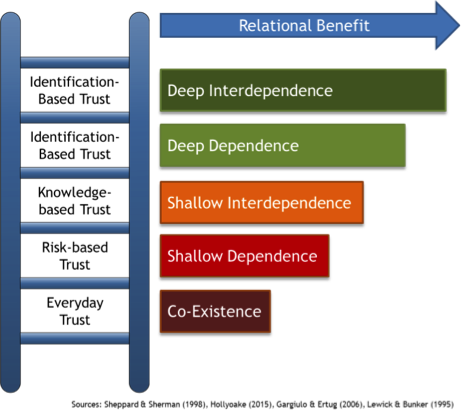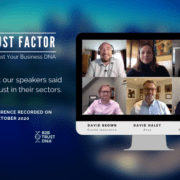Trust Ladder Part 3: Improving Performance
What are the common problems facing Customer Management organisations seeking to move up the Trust Ladder and how do they tackle them to improve performance?
Research from suppliers working in the automotive sector, fast moving consumer goods, and food service highlights ‘Deep Dependence’ as a core concern.
When organisations depend on a core group of customers for 80% their business – it can feel like being held ransom. Like all great relationships, it probably didn’t start this way.
The sense of working together for mutual benefit which brought them together has dissipated over time. Now the customer seems to be the one in control, calling the shots on value and volume. Over time the relationship has become a one way street which continuously erodes margins and customer profitability.
The question is how can organisations break out of it while keeping the customer onboard and pushing for profit?
This is where many suppliers get stuck within a cycle of holding on to business with decreasing levels of value, or holding it any cost as they work on internal cost savings and efficiencies. In short, they are Deeply Dependent.
Deep Dependence in itself is not all bad news.
It can act as springboard to strategic development and co-working; it may offer operating efficiencies through economies of scale, and push suppliers to improve their commercial skills.
The downside is that it may also lead to adversarial relationships, forcing customer service resources into fire-fighting activities, and towards over dependency as one division can mask interdependent relationships in another.
What’s the answer?
The solution lies in developing a CM experience which triggers trust, interdependence, and equitability together. Plans need to take the long-view based on customer insight, market knowledge and organisational strategy. They should include:
- Effective stakeholder mapping to identify all the interested parties, mapped to their importance within the organisation.
- Contact strategy development and implementation based on risk sharing and mutual benefits.
- Pro-active development of joint business plans as the umbrella for the relationship
- Evaluate the benefits of co-location
Before embarking on a course of action to move the relationship out of Deep Dependence and into Interdependence it is worth doing a check step!
The customer may be important at the moment, however, will this continue? A strategic customer review could surface any longer term potential they may be able to offer the organisation. Conversely, if the analysis indicates a decline in customers’ importance, organisations can plan accordingly and aim to move from Deep Dependence into Shallow Interdependence. A more strategic approach to customers could ensure better use of resources, processes, systems and way of working to secure longer term customer value.
Download The Trust Ladder e-book here
- Leap of Faith by Dr Mark Hollyoake featured in the Journal of Sales Transformation - May 13, 2024
- Stop hiding behind your computer and get out to see your customers! - March 6, 2024
- B2B Trust Research: What are Boundary Spanners? - January 31, 2024




 Customer Attuned
Customer Attuned